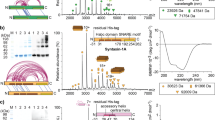Abstract
THREE synaptic proteins, syntaxin, SNAP-25 and synaptobrevin, were recently identified as targets of clostridial neurotoxins that irreversibly inhibit synaptic vesicle fusion1–4. Experiments searching for membrane receptors forN-ethylmaleimide-sensitive fusion protein (NSF), which has an important role in membrane fusion, revealed an ATP-dependent interaction of the same three synaptic proteins with NSF and its soluble attachment proteins5. Thus, two independent approaches identify syntaxin, synaptobrevin and SNAP-25 as components of the synaptic vesicle fusion machinery, but their mode of action is unclear6. We have now discovered a brain protein of relative molecular mass 67,000 (67K) which binds stably to syntaxin. Amino-acid sequencing and complementary DNA cloning revealed that the 67K protein is encoded by the mammalian homologue of the Caenorhabditis elegans gene unc-18. In C. elegans, unc-18 belongs to a group of genes defined by mutations with a paralytic phenotype and accumulations of acetylcholine, suggesting a defect in neurotransmitter release7,8. The binding of the mammalian homologue of unc-18 (Munc-18) to syntaxin requires the N terminus of syntaxin whereas that of SNAP-25 involves a more C-terminal sequence. Our data suggest that Munc-18 is a previously unidentified essential component of the synaptic vesicle fusion protein complex.
This is a preview of subscription content, access via your institution
Access options
Subscribe to this journal
Receive 51 print issues and online access
$199.00 per year
only $3.90 per issue
Buy this article
- Purchase on Springer Link
- Instant access to full article PDF
Prices may be subject to local taxes which are calculated during checkout
Similar content being viewed by others
References
Link, E. et al. Biochem. biophys. Res. Commun. 189, 1017–1023 (1992).
Schiavo, G. et al. Nature 359, 832–835 (1992).
Blasi, J. et al. Nature 365, 160–163 (1993).
Blasi, J. et al. EMBO J. (in the press) update?
Söllner, T. et al. Nature 362, 318–324 (1993).
Südhof, T. C., De Camilli, P., Niemann, H. & Jahn, R. Cell 75, 1–4 (1993).
Brenner, S. Genetics 77, 71–94 (1974).
Hosono, R. et al. J. Neurochem. 58, 1517–1525 (1992).
Inoue, I., Obata, K. & Akagawa, K. J. biol. Chem. 267, 10613–10619 (1992).
Bennett, M. K., Calakos, N. & Scheller, R. H. Science 257, 255–259 (1992).
Salzberg, A., Cohen, N., Halachmi, N., Kimchie, A. & Leve, Z. Development 117, 1309–1319 (1993).
Aalto, M. K., Ruohonen, L., Hosono, K. & Keranen, S. Yeast 7, 643–650 (1991).
Aalto, M. K., Keranen, S. & Ronne, H. Cell 68, 181–182 (1992).
Nonet, M. L., Grundahl, K., Meyer, B. J. & Rand, J. B. Cell 73, 1291–1305 (1993).
Perin, M. S., Fried, V. A., Mignery, G. A., Jahn, R. & Südhof, T. C. Nature 345, 260–261 (1990).
Alfonso, A., Grundahl, K., Duerr, J. S., Han, H-P. & Rand, J. B. Science 261, 617–619 (1993).
Pelham, H. R. B. Nature 364, 582 (1993).
Walch-Solimena, C. et al. Neuron (in the press).
Sollner, T., Bennett, M. K., Whiteheart, S. W., Scheller, R. H. & Rothman, J. E. Cell (in the press).
Novick, P. & Scheckman, R. Proc. natn. Acad. U.S.A. 76, 1858–1862 (1979).
Aalto, M. K., Ronne, H. & Keranen, S. EMBO J. 12, 4095–4104 (1993).
Bennett, M. K. et al. Cell 74, 863–873 (1993).
Pelham, H. R. B. Cell 73, 425–428 (1993).
Sambrook, J., Fritsch, E. F. & Maniatis, T. Molecular Cloning: A Laboratory Manual 2nd edn (Cold Spring Harbor Press, Cold Spring Harbor, New York, 1989).
Südhof, T. C. et al. Science 245, 1474–1480 (1989).
Guan, K. L. & Dixon, J. E. Analyt. Biochem. 192, 262–267 (1991).
Smith, D. B. & Johnson, K. S. Gene 67, 31–40 (1988).
Hata, Y., Davletov, B., Petrenko, A. G., Jahn, R. & Südhof, T. C. Neuron 10, 307–315 (1993).
Robinson, P. J. et al. Nature 365, 163–166 (1993).
Martin, R. G. & Ames, B. N. J. biol. Chem. 236, 1372–1379 (1961).
Author information
Authors and Affiliations
Rights and permissions
About this article
Cite this article
Hata, Y., Slaughter, C. & Südhof, T. Synaptic vesicle fusion complex contains unc-18 homologue bound to syntaxin. Nature 366, 347–351 (1993). https://doi.org/10.1038/366347a0
Received:
Accepted:
Issue Date:
DOI: https://doi.org/10.1038/366347a0
This article is cited by
-
Tetraspanin-8 sequesters syntaxin-2 to control biphasic release propensity of mucin granules
Nature Communications (2023)
-
The transcription factor unc-130/FOXD3/4 contributes to the biphasic calcium response required to optimize avoidance behavior
Scientific Reports (2022)
-
Aspects of Biological Replication and Evolution Independent of the Central Dogma: Insights from Protein-Free Vesicular Transformations and Protein-Mediated Membrane Remodeling
The Journal of Membrane Biology (2022)
-
Open syntaxin overcomes exocytosis defects of diverse mutants in C. elegans
Nature Communications (2020)
Comments
By submitting a comment you agree to abide by our Terms and Community Guidelines. If you find something abusive or that does not comply with our terms or guidelines please flag it as inappropriate.



